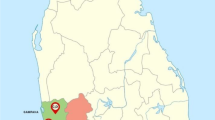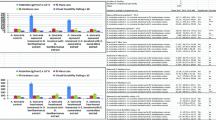Abstract
Agarwood trade has been growing rapidly due to its active ingredients composed of volatile substances, which are widely used in the cosmetics and pharmaceuticals. However, the formation time of agarwood in nature is quite long and little is known about its formation agents and mechanisms in planted Aquilaria crassna trees. In this study, biological, chemical and mechanical treatments were applied to 5-, 8-, and 11-year-old A. crassna plantations in north central, Vietnam. Agarwood samples were collected at 1 and 2 years after treatment. Oil content (Oc) in dry wood of A. crassna and sesquiterpene content in extracted oil were analyzed using hydrodistillation method and gas chromatography–mass spectrometry. The results indicated that 1 year after treatment, control (no treatment) and mechanical treatment (nails hammered to tree stems) had highest Oc (0.061–0.079 %) but lowest sesquiterpene content (2.1–7.1 %). Chemical treatment (mixture of acid sulfuric and sodium methyl bisulfate) had lowest Oc (0.038–0.039 %) but highest sesquiterpene content (15.8–20.8 %). While, 1 year after treatment biological treatments had Oc of 0.050–0.077 % and sesquiterpene content of 2.4–11.1 %. Two years after treatment, control still had lowest sesquiterpene content (3.2–7.0 %), while highest content (13.9–44.2 %) belonged to biological treatment (a mixture of fungi Phialophora spp. and Fusarium spp.). There was a total of 56 sesquiterpenes found in extracted oil from wood samples in biological treatments, which included eight highly commercially-valuable sesquiterpenes on international trade. Biological treatment with a mixture of fungi P. spp. and F. spp. should be encouraged to apply to 11-year-old A. crassna plantation, which resulted in highest sesquiterpene content (44.2 %).
Similar content being viewed by others
References
Adams RP (2001) Identification of essential oil components by gas chromatography/quadrupole mass spectroscopy. Allured Publishing, Carol Stream
Barden A, Anak NA, Mulliken T, Song M (2000) Heart of the matter: agarwood use and trade and CITES implementation for Aquilaria malaccensis. TRAFFIC International, Cambridge, pp 1–52
Blanchette R, Heuveling VBH (2009) Cultivated agarwood. US 7638145B2
Burkill IH (1966) A dictionary of the economic products of Malay Peninsula, vol 1. Ministry of Agriculture, Kuala Lumpur, pp 198–206
Caillot S, Rat S, Tavernier ML, Michaud P, Kovenskyb J, Wadouachib A, Clémenta C, Baillieula F, Petit E (2012) Native and sulfated oligoglucuronans as elicitors of defense-related responses inducing protection against Botrytis cinerea of Vitis vinifera. Carbohyd Polym 87:1728–1736
CIFOR (1996) Manual of forest fruits, seeds and seedlings, version 1.0. CD-Rom Publication No. 1, CIFOR, Bogor, Indonesia
Cui J, Wang C, Guo S, Yang L, Xao P, Wang M (2013a) Evaluation of fungus-induced agilawood from Aquilaria sinensis in China. Symbiosis 60:37–44
Cui J, Wang C, Guo S, Yang L, Xao P, Wang M (2013b) Effects of inoculating fungi on agilawood formation in Aquilaria sinensis. Chin Sci Bull 58:3280–3287
El-Sayed AM (2003) The pherobase. [Online URL:www.pherobase.com/database/compound/compounds-index.php]. Accessed May 10, 2014
Fujita M, Fujita Y, Noutoshi Y, Takahashi F, Narusaka Y, Yamaguchi-Shinozaki K, Shinozaki K (2006) Crosstalk between abiotic and biotic stress responses: a current view from the points of convergence in the stress signaling networks. Curr Opin Plant Biol 9:436–442
Ishihara M, Tsuneya T (1993) Components of the volatile concentrate of agarwood. J Essent Oil Res 5:283–289
Jalaluddin M (1977) A useful pathological condition of wood. Econ Bot 31:222–224
Mohamed R, Jong PL, Zali MS (2010) Fungal diversity in wounded stems of Aquilaria malaccensis. Fungal Divers 43:67–74
Naef R (2011) The volatile and semi-volatile constituents of agilawood, the infected heartwood of Aquilaria species: a review. Flavour Frag J 26:73–89
Ng LT, Chang YS, Kadia AA (1997) A review of Agar (Gaharu) producing Aquilaria spp. J Trop For Prod 2:272–285
Pojanagaroon S, Kaewrak C (2003) Mechanical method to stimulate aloeswood formation in Aquilaria crassna (Kritsana) trees. Acta Hort 676:161–166
Qi SY, He ML, Lin LD, Zhang CH, Hu LJ, Zhang HZ (2005) Production of 2-(2-phenylethyl) chromones in cell suspension cultures of Aquilaria sinensis. Plant Cell Tiss Org 83:217–221
Rahman MA, Basak AC (1980) Agar production in agar trees by artificial inoculation and wounding. Bano Bigan Patrika 9:86–93
Selosse MA, Baudoin E, Vandenkoornhuyse P (2004) Symbiotic microorganisms, a key for ecological success and protection of plants. CR Biol 327:639–648
Son NH, Thanh LV (2012) Current status of Aquilaria development in Vietnam. Agriculture Publishing House, Hanoi
Son NH, Quat NX, Thanh LV, Ban DV (2011) Research on current status and sustainable development for Aquilaria spp. In Vietnam. Scientific Report, Vietnamese Academy of Forest Sciences. Hanoi
Tabata Y, Widjaja E, Mulyaningsih T, Parman I, Wiriadinata H, Mandang YI, Itoh T (2003) Structural survey and artificial induction of aloeswood. Wood Res 90:11–12
Tamuli P, Boruah P, Nath SC, Leclercq P (2005) Essential oil of eaglewood tree a product of pathogenesis. J Essent Oil Res 17:601–604
Thanh LV (2013) Research on biological characteristics and silvicultural measures to sustainable develop Aquilaria spp. In Vietnam. Ph.D. dissertation. Vietnamese Academy of Forest Science, Hanoi
Uddin MS, Mukul SA, Khan MASA, Alamgir M, Harun MD, Alam MS (2008) Small-scale Agar (Aquilaria agallocha Roxb.) Based Cottage Enterprises in Maulvibazar District of Bangladesh: production, Marketing and Potential Contribution to Rural Development. Small-scale For 7:139–149
Wang XH, Zhang CH, Yang LL, Gomes-Laranjo J (2011) Production of dragon’s blood in Dracaena cochinchinensis plants by inoculation of Fusarium proliferatum. Plant Sci 180:292–299
Wetwitayaklung P, Thavanapong N, Charoenteeraboon J (2009) Chemical constituents and antimicrobial activity of essential oil and extracts of heartwood of Aquilaria crassna obtained from water distillation and supercritical fluid carbon dioxide extraction. Silpakorn Univ Sci Technol J 3:25–33
Yagura T, Shibayama N, Ito M, Kiuchi F, Honda G (2005) Three novel diepoxy tetrahydrochromones from agarwood artificially wounded by intentional wounding. Tetrahedron Lett 46:4395–4398
Zhang Z, Yang Y, Wei JH (2010) Advances in studies on mechanism of agilawood formation in Aquilaria sinensis and its hypothesis of agilawood formation induced by defense response. Chin Tradit Herbal Drugs 41:156–159
Zhang Z, Zhang X, Yang Y, Wei J, Meng H, Gao Z, Xu Y (2014) Hydrogen peroxide induces vessel occlusions and stimulates sesquiterpene accumulation in stems of Aquilaria sinensis. Plant Growth Regul 72:81–87
Zhao J, Davis LC, Verpoorte R (2005) Elicitor signal transduction leading to production of plant secondary metabolites. Biotechnol Adv 23:283–333
Acknowledgments
This research is funded by Vietnam National Foundation for Science and Technology Development (NAFOSTED) under grant number 106-NN.06-2013.01. Comments from anonymous reviewers were highly appreciated.
Author information
Authors and Affiliations
Corresponding author
Appendix
Appendix
See Table 4
Rights and permissions
About this article
Cite this article
Van Thanh, L., Van Do, T., Son, N.H. et al. Impacts of biological, chemical and mechanical treatments on sesquiterpene content in stems of planted Aquilaria crassna trees. Agroforest Syst 89, 973–981 (2015). https://doi.org/10.1007/s10457-015-9829-3
Received:
Accepted:
Published:
Issue Date:
DOI: https://doi.org/10.1007/s10457-015-9829-3




